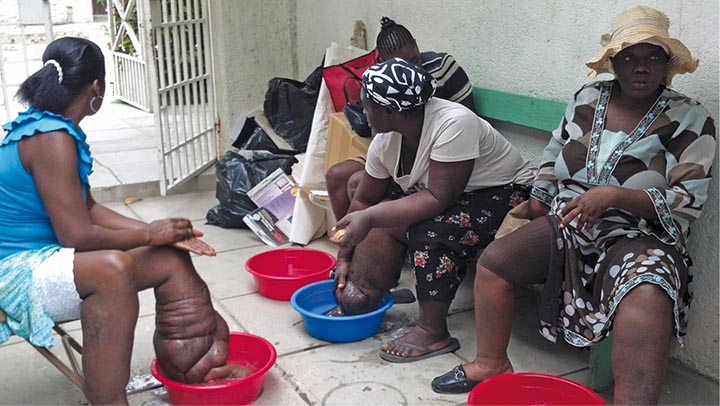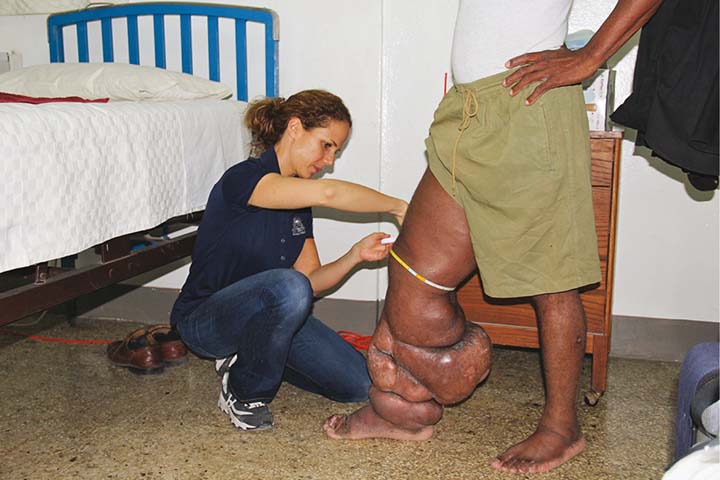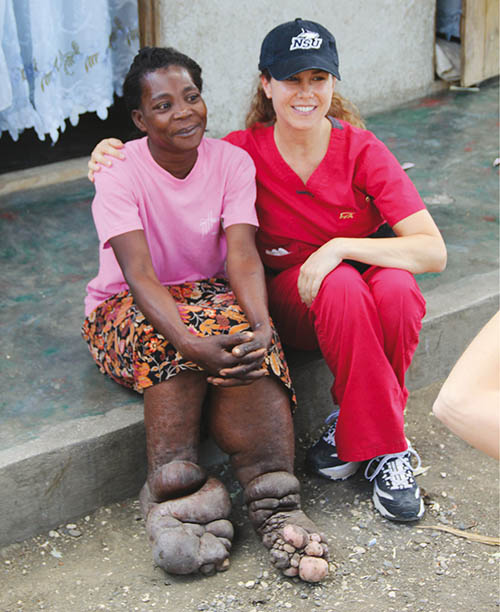Volume 25 Number 3
Establishing a lymphatic filariasis morbidity plan for Haiti
Heather Hettrick
Keywords Lymphatic filariasis, Haiti, morbidity plan
Abstract
Lymphatic filariasis (LF) is a parasitic infection that is the leading cause of disability in the world. In Haiti, LF is considered a national disease, with many people suffering from the disfiguring and disabling effects of the disease. Eradication efforts have been under way since 1997 with projections for no new transmissions by 2020. As eradication nears, the focus has shifted to morbidity management as many patients with LF suffer from the debilitating effects of lymphoedema and hydrocele. Although there is no cure, treatment is available, leading to significant outcomes. Patients managed at the clinic in Léogâne achieved reductions in limb volume, improved skin integrity, independence with self-care, enhanced quality of life, improvements in functional abilities and activities of daily living, the ability to return to work and experienced reduced perceptions of social stigma.
Background and Scope of the Problem
Lymphatic filariasis (LF) is the leading cause of disability in the world. Current World Health Organization estimates suggest 954 million people in 54 countries are at risk for contracting LF, which is one of 13 neglected tropical diseases and one of only six infectious diseases considered eliminable by the World Health Assembly. In 2000, over 120 million people were infected, with 40 million suffering from the disfiguring and debilitating aspects of this disease1. In the western hemisphere, Haiti (particularly Léogâne) has been hardest hit.
LF is a disease caused by parasitic worms spread to people by mosquitoes. There are three types of filarial worms (nematodes from the roundworm family, Filarioidea). Wuchereria bancrofti cause 90% of LF cases in Africa, Asia, Pacific Islands and the Americas. The remaining 10% of LF cases are attributed to Brugia malayi affecting those primarily in Asia and the Pacific Islands. Brugia timori has also been identified to cause the disease1.
When an infected mosquito takes a blood meal, the worms are deposited on the skin. The worms find their way to the lymphatic vessels, the most common areas being the inguinal nodes and lymphatics of the lower extremities. Over 6–12 months, the worms develop into adult worms (average lifespan of 6–8 years) where they breed and release millions of microfilariae which live in the blood. When a mosquito takes a blood meal, they pick up the circulating microfilariae which then develop into worms in the mosquito over 7–10 days. The worms can then be spread to other people by another blood meal taken from an infected mosquito, thus continuing the cycle of transmission. While living in the human host, the microfilariae and worms damage/destroy the lymphatic system. Many people with LF have no clinical signs of the disease although their lymphatic vessels and structures are damaged. Infection typically occurs in childhood with clinical manifestations of LF (lymphoedema of the extremities and hydrocele of the scrotum) often appearing in early adulthood2.
Haitian Impact
LF is considered a national disease in Haiti as it is present in 118 of 140 communes, making 88% of the country at risk. In specific hyperendemic zones, nearly 45% of the population is infected with LF3. Estimates suggest up to 5% of the Haitian population suffers from lymphoedema associated with LF. Many women and girls suffer from leg elephantiasis; however, along the coastal towns of Haiti, nearly half the people have LF and 25% of the males have genital lymphoedema and scrotal damage due to the disease (hydrocele); this is often hidden and unreported.
Elimination efforts through mass drug administration have been underway in Haiti since 1997 and the World Health Assembly has set a timetable for worldwide elimination by 2020; meaning no new cases of LF would be contracted. However, for those who currently have the disease many are disfigured and disabled, rendering them unable to work, others suffer from skin infections and pain and many are rejected and stigmatised by their own families and society at large.
Significance of Léogâne
Founded in 1997 by Fr. Tom Streit, the University of Notre Dame Haiti Program (UNDHP) has worked with the Haitian Ministry of Public Health and the Population, including the Centers for Disease Control (CDC), Gates Foundation and other partners on eliminating the blight of LF from Haiti, and to help build a model for programs in 82 other affected countries.
Léogâne is a hyperendemic area for LF given its lush tropical climate and large populous. Léogâne also has a large, 120-bed general hospital, Hospital Sainte Croix, which is the base of operations for the regional health care program serving the local commune and surrounding communities in the Republic of Haiti. The regional health programme has six mobile clinics which serve remote mountain villages as well as sites in nearby coastal areas. Efforts have been made to establish the LF clinic at the hospital as a centre of excellence for LF management, and create satellite clinics around Haiti to provide LF morbidity management.
The hospital operates an outpatient clinic, has three surgical suites, a pharmacy, a laboratory, an x-ray department and a guest house for visitors and volunteers. Further, the UNDHP has offices and research laboratories in the hospital complex for the management and study of LF.
Developing a Morbidity Plan
In Haiti, the focus is shifting to morbidity management. In 2012, renewed efforts were put forward to establish a morbidity management programme based in Léogâne at Hospital Sainte Croix. The International Lymphedema and Wound Training Institute (ILWTI), along with ILWTI Medical Missions, Nova Southeastern University, the relief project medi for help, the University of Notre Dame and the Brazilian Embassy worked collaboratively to provide education and training to local Haitians who were interested in working in the clinic. A series of training programmes were hosted between December 2012 and August 2013. These programmes provided the requisite knowledge to appreciate the pathophysiology associated with LF, along with didactic and hands-on training involving modified protocols encompassing Complete Decongestive Therapy and basic skin and wound care principles. The education was designed to be a train-the-trainer type programme. A unique aspect was the introduction of modified manual lymph drainage and compression as traditional morbidity methods focused on hygiene, limb elevation and basic exercise. ILWTI and ILWTI Medical Missions established the modified protocols implemented at the LF clinic in Léogâne with good outcomes.

Hygienic care
Clinical space was provided on Hospital Sainte Croix grounds by the University of Notre Dame. Supplies were donated from many sources and hand-couriered to the clinic in Haiti. The clinic was officially open to provide morbidity management on 1 September 2014. The plan and vision involved linking community advocates (Animatrices), who monitored and tracked patients with LF throughout Léogâne, to direct patients to come to the clinic for treatment. Three Haitian-trained LF technicians were hired to work and run the clinic; two of the three were actual LF patients themselves. The technicians taught the patients proper skin care and hygiene and provided modified protocols involving manual lymph drainage, diaphragmatic breathing, compression, patient education and basic wound care. The goal was to have volunteer lymphoedema and wound specialist teams work in the clinic one week per month to provide ongoing education and training for the Haitian staff as well as provide comprehensive and intensive treatment to a large number of patients (100 or more per week). As part of the monthly visits, the volunteers would hand courier donated supplies (wound care, compression) to restock the clinic of needed supplies. For the weeks when the volunteers were not on site, the technicians would continue to provide the necessary treatments until a significant reduction in limb volume was achieved. At such time, patients were provided with a compression device that was adjustable and user-friendly that would enable the patients to maintain the reduced limb size.

Haitian man suffering from LF
The results were quite impressive; on average, for patients with more advanced stages of LF, limbs reduced 10–30 cm after 2–4 days of intensive treatment. Patients who were experiencing acute attacks were provided topical and systemic antibiotic therapies provided by the clinic and hospital. Patients with systemic infections or significant wound complications were referred to Hospital Sainte Croix or the wound programme at Hospital Bernard Mevs in Port au Prince. Nail care, fungal infections and minor skin lesions and impairments were adequately managed by the trained technicians.
Compression bandaging supplies, wound care products, and long-term compression garments and wraps are very expensive. Fortunately, ILWTI Medical Missions received generous donations from many companies to provide supplies for LF treatment. The compression bandages used with patients during the modified intensive phase were cleaned and recycled for use on other patients once the limb reduced enough to fit into either a stocking or compression wrap with Velcro® closure for long-term use and maintenance. Local resources need to be explored and the potential for local fabrication of compression wraps needs to be considered.

Heather Hettrick with Haitian woman suffering from LF during home visit.
Outcomes and Challenges
A significant number of patients have been treated with the modified protocols in Léogâne, Haiti. Overall, the results have been impressive including, but not limited to: significant reductions in limb volume; improved skin integrity; independence with self-care; enhanced quality of life; improvements in functional abilities and activities of daily living; ability to return to work; and reduced perceptions of social stigma.
Success also derives difficulties, particularly in resource-challenged nations and in working with different cultures. Expectations, roles and responsibilities should be clearly stated from the beginning. Volunteers and assistance from outside the country should not foster a sense of enablement, but rather empowerment. The ultimate goal is to establish a sustainable, locally run and operated clinic servicing the needs of the local community as well as satellite clinics throughout the nation.
The clinic is now being run by the University of Notre Dame which has employed three local Haitians to provide care and spearhead the day-to-day operations of the clinic. Day-to-day operations include responsibility for inventory control, supply coordination, outcome tracking and synchronisation of services through community outreach. Although volunteers are not currently supporting the clinical efforts, companies such as mediUSA (medi for help is the relief project set up by mediUSA) for help continue to donate supplies (like circaid®) and other resources. Local health care professionals are ideally suited to be trained in the modified protocols to manage the LF-related lymphoedema and skin impairments. A new initiative is currently under way to address this aspect.
Opportunities for Lasting Impact
The Université Episcopale d’Haïti, Faculté des Sciences de Réhabilitation de Léogâne is a Physical and Occupational Therapy Program in Léogâne. Faculty, curriculum development and oversight is being provided by the Medical University of South Carolina. They have not only created a robust, three-year programme, but have a focus on LF and wound management to address the unique needs of their fellow countrymen. Volunteer faculty from the World Alliance of Wound and Lymphedema Care (WAWLC) with support from medi for help, will be providing the education for this programme, beginning in autumn 2017.
Conclusion
Working to establish a sustainable LF morbidity plan for Haiti has been a tremendously rewarding humanitarian experience for all those involved. The lessons learned in Léogâne can serve as a model for the world on how to successfully establish morbidity management for patients suffering from LF. As eradication nears, the focus needs to shift to address the debilitating and disfiguring aspects of this manageable disease. This can be achieved through collaboration and the generous contribution of time, expertise and resources (human and financial) among those who have a vested interest in helping others, particularly in resource-challenged areas.
Acknowledgements
Thank you to the patients and technicians in Haiti for the opportunity to help. Thank you to John Macdonald MD, Fr. Tom Streit, Project Medishare, medi for help, the International Lymphedema and Wound Training Institute, University of Notre Dame and the many wonderful humanitarian volunteers who helped to make this LF clinic a reality.
Author(s)
Heather Hettrick
PT, PhD, CWS, CLT-LANA, CLWT
Associate Professor
Department of Physical Therapy
Nova Southeastern University, Florida, USA
Email hh124@nova.edu
References
- World Health Organization. http://www.who.int/mediacentre/factsheets/fs102/en/ Accessed July 5, 2017.
- Center for Disease Control. https://www.cdc.gov/parasites/lymphaticfilariasis/ Accessed July 6, 2017.
- LF in Haiti. http://haiti.nd.edu/lymphatic-filariasis/lf-in-haiti/ Accessed July 6, 2017.



